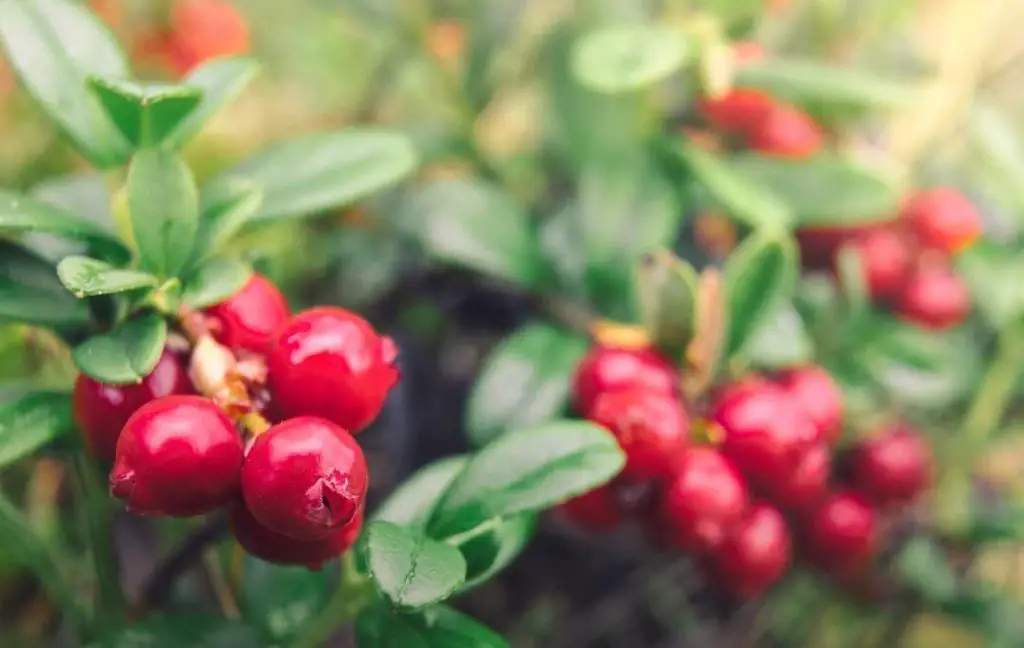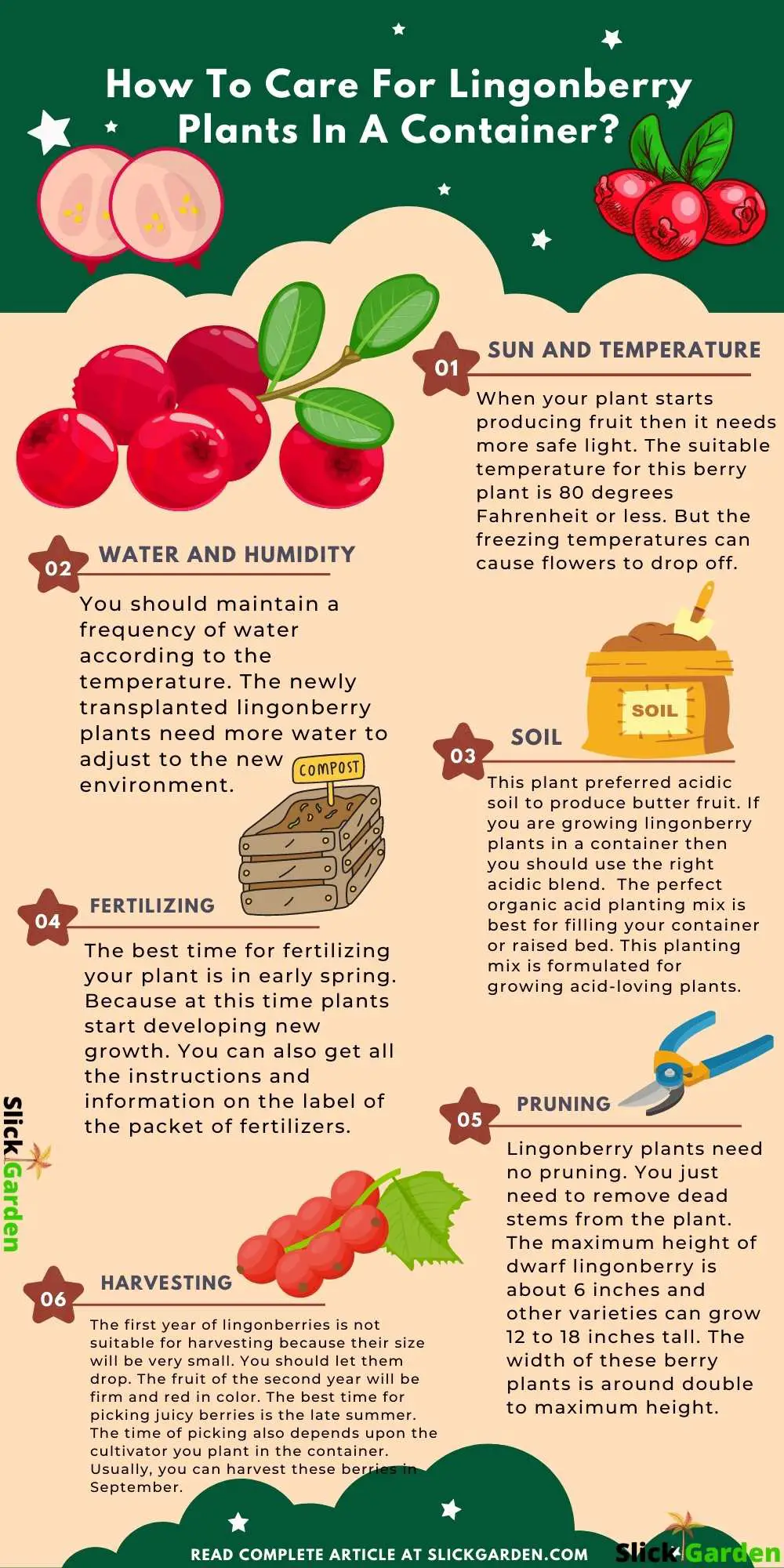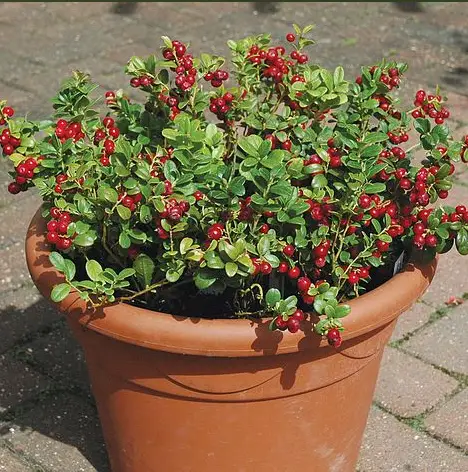Blueberries and cranberries are, relative to lingonberries, very delicious and need little maintenance. Lingo berries have half-inch tiny leaves that grow from the stem.
With time, the base of the plant becomes Woody but continuously produces new growth. When your plant is one-year-old it will start producing fruit.
Lingonberry plants produce delicate inch pink or white bell-shaped flowers. This plant produces flowers in Spring and early summer.
Lingonberry plants can easily tolerate poor and sandy soil. They can survive in cold-sensitive to the high temperatures but you can grow them in warm climates in the shade.
When To Plant Lingonberry?
Every plant needs specific conditions to grow, they can’t adapt to every climate. In the same way, lingonberry plants like to grow in cold environments.
It is better to plant them in early spring or mid to late fall. When you grow Lingo very plants at the right time then tender roots will be established before the weather changes.
Growing Lingonberries In Containers

The roots of lingonberries are shallow, that’s why they can easily be adjusted in a pot or container. The maximum height of a plant of lingonberries is up to 18 inches or 46 cm.
The best size container or pot for growing lingonberries must be 10 to 12 inches or 25 to 31cm.
You can buy ready-made plants of lingonberries from any local nursery. But the other ways of growing these yummy berries are from seeds, division, and cuttings.
How To Grow Lingonberries From Seed?
- You can grow lingonberries from seed but this process is very difficult and slow. For this purpose, you need overripe berries. Because when the berries are ripe they produce tiny seeds inside them. The older berries produce more seeds.
- Crush all the selected lingonberries in a cup of water. Leave them in the water for at least two weeks to one month. This will help them to ferment without drying out. This process also helps to differentiate between good and bad seeds. The pulp and bad seeds of lingonberries will start floating up to the surface of the water. The good seeds that you can easily use in planting will sink to the bottom.
- When the process of fermentation and date you can skim off the junk and drain off the water. During draining the water you should be careful otherwise the tiny seeds will lose.
- After draining the seeds from the water you should at once plant them in a small pot. Never let the seeds dry out post-fermentation. The pot you are using for growing must have a high-quality potting mix. The potting mix must contain two parts of moistened peat moss and one part of perlite. This starter mix is perfect for growing lingonberries.
- You can use a smaller pot for preparing seedlings for transplanting. You can plant 10 seeds in a pot. Place all the seeds on the surface of the soil and not cover them with soil. For humid environments, you can also cover the container or a pot with a clear greenhouse cover. For the germination of seeds, you should place your container or pot in a cool but bright location.
- You should keep an eye on the moisture level of the soil.
- The new young plants are very delicate and susceptible to changes in temperature and light. If your container or pot is overcrowded then you can transplant them to a larger pot or container.
- Before transplanting seedlings outdoors you should first harden them off slowly.
How To Grow Lingonberries From Cutting?
- For growing lingonberries, you should need a stem. The length of the stem should be 4 inches and it should be from a healthy plant. The stem should be vigorous and not woody.
- After selecting the stamp you can cut it from the base. you should remove all the leaves from the bottom part of the stem. You should leave a few leaves on the top of the stem.
- The next step is giving the bottom of the stamp into a crowded rooting hormone.
- The container you are using for growing lingonberries must have drainage holes at the bottom. Drainage is very important for the growth of any plant. Drainage can prevent your plant from any fungal diseases and root rot. Fill the container and pot with a high-quality potting mix. You must use two parts of peat moss and one part of perlite for more nourishing growth of these cuttings.
- Your container is ready for planting stem cutting of lingonberries. Take a pencil and make holes in the high-quality potting mix. Now insert the cuttings in the holes.
- Now water your newly planted cutting because they need a humid environment and bright light to adjust in the new container. As you know lingonberries need low temperatures so you should keep the soil moist. After one month the cutting started producing new roots.
How To Grow Lingonberries From Root Division?
You can also start lingonberry plants by root division. If you have a large and healthy lingonberry plant then you can cut down the center of the plant with the help of a clean and sharpened shovel.
Now gently plant it in your desired container. Use the best quality soil for filling the container. Make sure you are providing all suitable conditions.
How To Care For Lingonberry Plants In A Container?

Your lingonberry plants need the right conditions to grow. Here are some factors that are essential for lingonberry plants.
SUN AND TEMPERATURE
Some plants need less sunlight and some more. You should be careful about the intensity of the sun for lingonberry plants because the heat of the sun can cause scorching on the young leaves of the plant.
When your plant starts producing fruit then it needs more safe light. The suitable temperature for this berry plant is 80 degrees Fahrenheit or less. But the freezing temperatures can cause flowers to drop off.
WATER AND HUMIDITY
Humidity also plays a very important role in the process of germination of seeds. The moisture level of the soil is very important in the growth of lingonberry plants.
You should maintain a frequency of water according to the temperature. The newly transplanted lingonberry plants need more water to adjust to the new environment.
SOIL
This plant preferred acidic soil to produce butter fruit. If you are growing lingonberry plants in a container then you should use the right acidic blend.
The perfect organic acid planting mix is best for filling your container or raised bed. This planting mix is formulated for growing acid-loving plants. If your planting mix has bark fines and peat moss then it will help to retain the moisture level in the soil.
You can add fine sand to improve the draining quality of the soil. The well-drained soil helps to prevent your plants from root rot and many fungal diseases.
You can also amend your soil by adding kelp meal, worm casting, kapok seed meal, and bat guano as fertilizers. Acidic soil is perfect for growing lingonberries.
This berry plant will produce fruit if the pH of the soil is between 4.3 to 5.5. The pH level above 6 is not good for lingonberry plants. If you use the right soil for filling your containers then it is easier for you to start planting lingonberries.
FERTILIZING
You should use a fertilizer that is formulated for acid-loving plants because lingonberry prefers the acidifying ammonium form. You can also use those fertilizers that are perfect for blueberries.
The fertilizer contains beneficial microbes, humic acid, dehydrated manure, sulfur, alfalfa meal, and sulfate of potash can enhance the richness of your soil and give strength to your lingonberry plants.
The best time for fertilizing your plant is in early spring. Because at this time plants start developing new growth. You can also get all the instructions and information on the label of the packet of fertilizers.
The manufacturers suggest you the instructions for growing healthy lingonberry plants. You will get all the information about the amount of fertilizer you should apply.
If you apply too much fertilizer then you can see the fast growth of the plant and the color of the leaves turn dark green. In case you are applying too little fertilizer then the leaves will start turning yellow or red.
PRUNING
Lingonberry plants need no pruning. You just need to remove dead stems from the plant. The maximum height of dwarf lingonberry is about 6 inches and other varieties can grow 12 to 18 inches tall. The width of these berry plants is around double to maximum height.
When your plant reaches the maximum and you see it will start to get a bit leggy then it needs light remaining. For maintaining the height and width of the plant you just only remove the dead stem from the plant.
Harvesting
The first year of lingonberries is not suitable for harvesting because their size will be very small. You should let them drop. The fruit of the second year will be firm and red in color.
The best time for picking juicy berries is the late summer. The time of picking also depends upon the cultivator you plant in the container. Usually, you can harvest these berries in September.
If you are living in a warm climate then you can harvest lingonberries two times a year. One harvest can be done in the middle of summer and the other in the late fall.
After the first harvest, lingonberry plants start producing flowers again and you will get a second harvest.
You should only pick ripe fruit. The best way of picking berries is by hand as you have a small harvest in containers. In case you are growing many lingonberry plants in several containers then you can use a berry rake to make harvesting easier.
The quantity of fruit depends upon the cultivar you have grown in the desired container. You will get a large number of harvests if you provide suitable conditions for lingonberries.
Every year you can get half to one pound of berries from each plant. In warmer areas, you will get a small harvest because of heat stress.
Storing And Preserving Lingonberries
For storing lingonberries, you can use a plastic bag with ventilation holes. The way of storing these berries is similar to other berries. You can keep them for one month in a refrigerator. If you want the best taste of these berries then you should eat them fresh.
If you want to preserve lingonberries for a long time then freezing is the best process. The other way of preserving it is drying through either freeze-drying or dehydration.
You can rehydrate lingonberries later and use them in a powdered form in other foodstuffs. You can also make yummy and tasty jam, jellies, and syrup from lingonberries.

